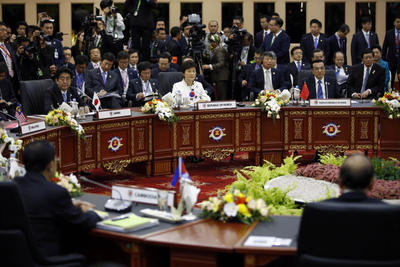One of the three pillars of the ASEAN Community (along with the ASEAN Political and Security Community and the ASEAN Socio-Cultural Community), the AEC is generally taken to refer to the desired free flow of goods and services, or the substantial integration of the regional economy and, therefore, increased regional competition.
ASEAN is still far from being economically integrated as a region. And there is little prospect that it will be fully integrated, as envisioned, in the near future, much less by 2015. But whether or not the AEC is achieved by 2015 should not be held against the literal rendering of the specific measures to realise ASEAN economic integration, as provided for in the Strategic Schedule appended to the AEC Blueprint. Rather, the plan to realise the AEC by 2015 should be looked at as a re-affirmation of the ASEAN leaders’ aspiration for, and commitment to, efficiency in trading, market openness and links with the international community. The year 2015 should be considered not as a hard-and-fast target, in which ASEAN, its objectives and the way it conducts business are suddenly transformed. Rather, it should be regarded as a benchmark to help measure ASEAN’s progress toward regional economic integration.
It should, however, still be recalled that ASEAN member countries have committed themselves to carry out certain measures that are intended to lead to regional economic integration within a given timeframe. While ASEAN should not be condemned for its members’ failure to make good on their commitments, any failure to deliver will likely lead to a loss of credibility and could mean that member countries fall further behind in the global competition for export markets and foreign direct investment (FDI).
ASEAN will undoubtedly miss a number of targets defined in the AEC Blueprint, but the ASEAN spirit is still going strong. Moreover, the AEC should not be considered in separation from the other two components of the ASEAN Community: ASEAN’s supreme achievements have been in the political and security areas. By building confidence and dispelling mutual suspicion between members through frequent meetings and other cooperative activities, ASEAN has made Southeast Asia’s impressive economic growth possible. This has, in turn, enticed major global powers to seek, for strategic and economic reasons, relationships with the Association as a group. Some observers may be disappointed by ASEAN’s failure to ‘resolve’ legal sovereignty and jurisdictional disputes involving member states, but they forget that ASEAN is not an adjudicating body and was never meant to function as such.
The task of raising ASEAN’s public profile belongs to the ASEAN Socio-Cultural Community, and is essential if this and the AEC are to be effective or even realised. Partly for this reason, some observers have deplored the low level of ASEAN awareness among ‘the people’, forgetting the fact that building awareness of any regional association takes time, that the level of regional awareness and identity in Southeast Asia is higher than in most other regional associations of sovereign states, that ASEAN’s expansion to include today’s 10 members took place only in 1999, and that many Europeans are aware of the European Union because, thanks to this organisation, they can legally live, work and/or study just about anywhere in Europe — conditions that affect the daily lives of people in Europe, but are absent in Southeast Asia. By all means, let us think and talk about ASEAN, but on the basis of the current reality and the present facts. Let us acknowledge what ASEAN is and is not, what ASEAN can and cannot do.
Rodolfo C. Severino is the head of the ASEAN Studies Centre, Institute of Southeast Asian Studies, Singapore. He is a former ASEAN secretary-general. The views expressed here are his alone.
A version of this article was first published by The Straits Times in Singapore on 3 January 2014.


The author is very practical in his criticism. He rightly said that the spirit of ASEAN is still glowing strong but how far they are behind in shaping it like EU is anybody’s guess. There are several political, social, regional, ethnic, linguistic and religious differences among ASEAN members and it is not an easy task to emerge above these deep rooted obstacles. The rivalry between China and the USA also plays a crucial role in their success or failure.
A very fair and constructive assessment, Rodolfo.
Thank you
Andrew